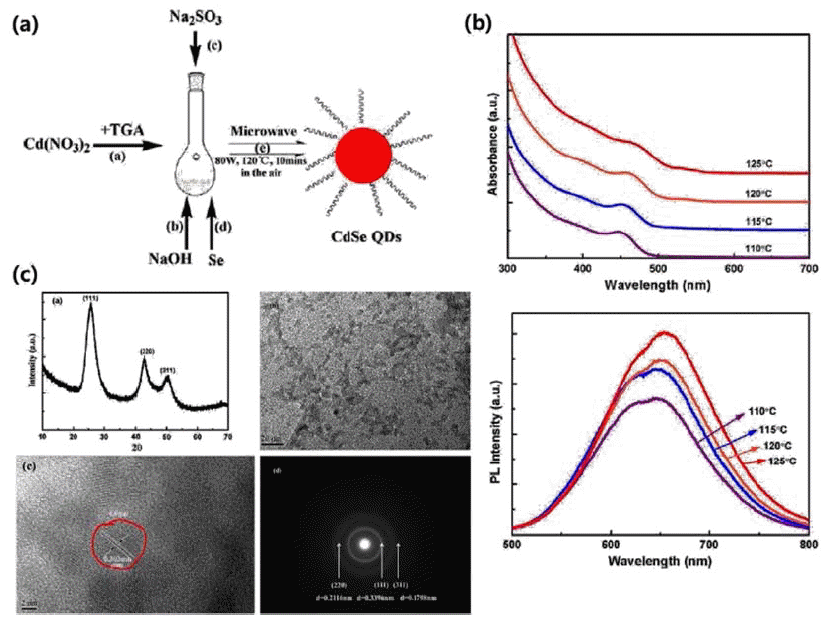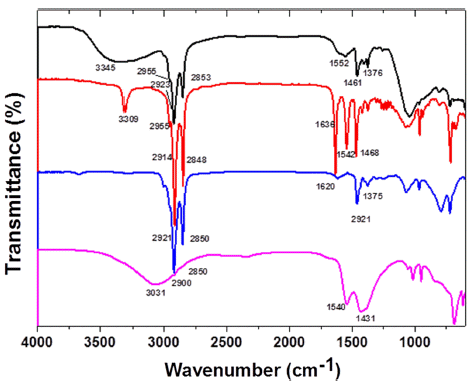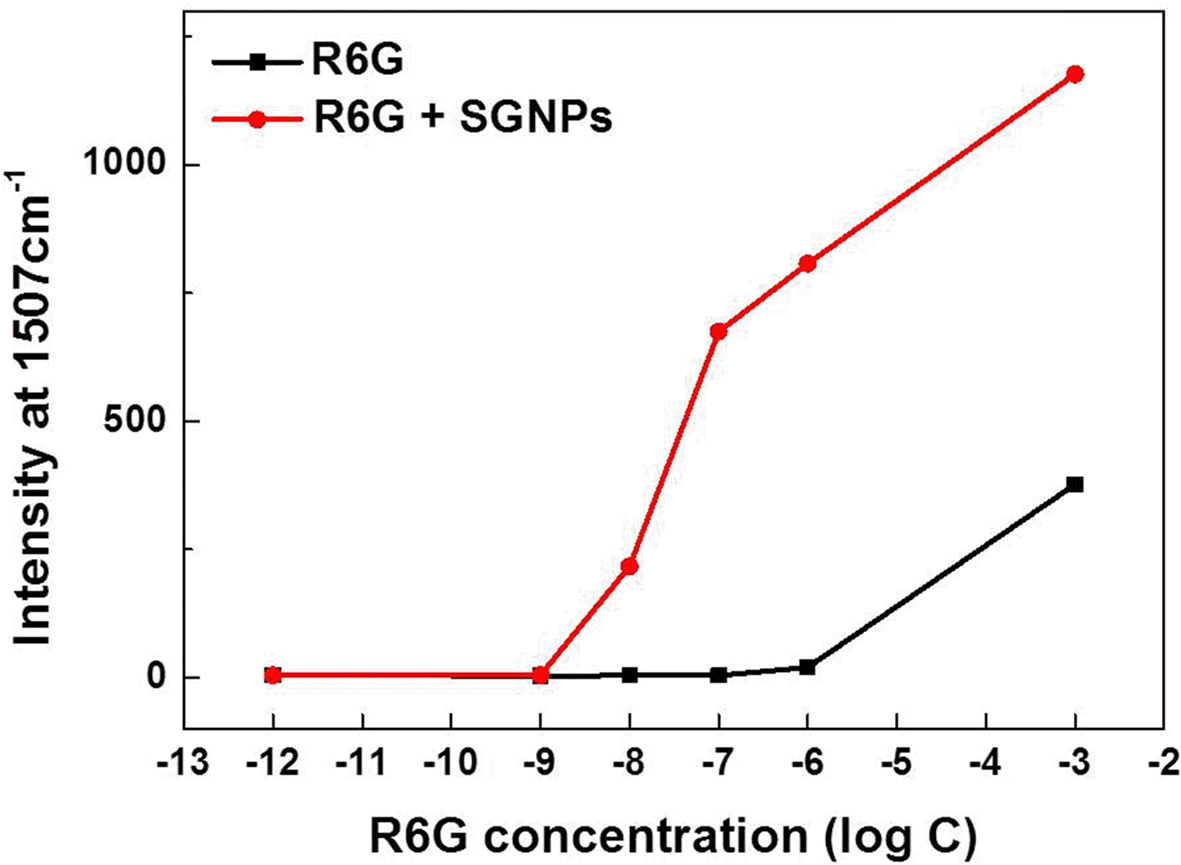Search
- Page Path
- HOME > Search
- [Korean]
- Recent Developments in Synthesis of Colloidal Quantum Dots
- Jae-Yong Jung, Jong-Pal Hong, Young-Kuk Kim
- J Korean Powder Metall Inst. 2018;25(4):346-354. Published online August 1, 2018
- DOI: https://doi.org/10.4150/KPMI.2018.25.4.346

- 1,510 View
- 10 Download
-
 Abstract
Abstract
 PDF
PDF Over the last decade, the study of the synthesis of semiconductor colloidal quantum dots has progressed at a tremendous rate. Colloidal quantum dots, which possess unique spectral-luminescent characteristics, are of great interest in the development of novel materials and devices, which are promising for use in various fields. Several studies have been carried out on hot injection synthesis methods. However, these methods have been found to be unsuitable for large-capacity synthesis. Therefore, this review paper introduces synthesis methods other than the hot injection synthesis method, to synthesize quantum dots with excellent optical properties, through continuous synthesis and large capacity synthesis. In addition, examples of the application of synthesized colloid quantum dots in displays, solar cells, and bio industries are provided.
- [Korean]
- Synthesis of Hexagonal Boron Nitride Nanocrystals and Their Application to Thermally Conductive Composites
- Jae-Yong Jung, Yang-Do Kim, Pyung-Woo Shin, Young-Kuk Kim
- J Korean Powder Metall Inst. 2016;23(6):414-419. Published online December 1, 2016
- DOI: https://doi.org/10.4150/KPMI.2016.23.6.414

- 1,088 View
- 17 Download
-
 Abstract
Abstract
 PDF
PDF Much attention has been paid to thermally conductive materials for efficient heat dissipation of electronic devices to maintain their functionality and to support lifetime span. Hexagonal boron nitride (h-BN), which has a high thermal conductivity, is one of the most suitable materials for thermally conductive composites. In this study, we synthesize h-BN nanocrystals by pyrolysis of cost-effective precursors, boric acid, and melamine. Through pyrolysis at 900°C and subsequent annealing at 1500°C, h-BN nanoparticles with diameters of ~80 nm are synthesized. We demonstrate that the addition of small amounts of Eu-containing salts during the preparation of melamine borate precursors significantly enhanced the crystallinity of h-BN. In particular, addition of Eu assists the growth of h-BN nanoplatelets with diameters up to ~200 nm. Polymer composites containing both spherical Al2O3 (70 vol%) and Eu-doped h-BN nanoparticles (4 vol%) show an enhanced thermal conductivity (λ ~ 1.72W/mK), which is larger than the thermal conductivity of polymer composites containing spherical Al2O3 (70 vol%) as the sole fillers (λ ~ 1.48W/mK).
- [Korean]
- Improved Luminescent Characterization and Synthesis of InP/ZnS Quantum Dot with High-Stability Precursor
- Eun-Jin Lee, Jong-Woo Moon, Yang-Do Kim, Pyung-Woo Shin, Young-Kuk Kim
- J Korean Powder Metall Inst. 2015;22(6):385-390. Published online December 1, 2015
- DOI: https://doi.org/10.4150/KPMI.2015.22.6.385

- 750 View
- 3 Download
- 2 Citations
-
 Abstract
Abstract
 PDF
PDF We report a synthesis of non-toxic InP nanocrystals using non-pyrolytic precursors instead of pyrolytic and unstable tris(trimethylsilyl)phosphine, a popular precursor for synthesis of InP nanocrystals. In this study, InP nanocrystals are successfully synthesized using hexaethyl phosphorous triamide (HPT) and the synthesized InP nanocrystals showed a broad and weak photoluminescence (PL) spectrum. As synthesized InP nanocrystals are subjected to further surface modification process to enhance their stability and photoluminescence. Surface modification of InP nanocrystals is done at 230°C using 1-dodecanethiol, zinc acetate and fatty acid as sources of ZnS shell. After surface modification, the synthesized InP/ZnS nanocrystals show intense PL spectra centered at the emission wavelength 612 nm through 633 nm. The synthesized InP/ZnS core/shell structure is confirmed with X-ray diffraction (XRD) and Inductively Coupled Plasma - Atomic Emission Spectrometer (ICP-AES). After surface modification, InP/ZnS nanocrystals having narrow particle size distribution are observed by Field Emission Transmission Electron Microscope (FE-TEM). In contrast to uncapped InP nanocrystals, InP/ZnS nanocrystals treated with a newly developed surface modified procedure show highly enhanced PL spectra with quantum yield of 47%.
-
Citations
Citations to this article as recorded by- Synthesis and luminescence characteristics of manganese-doped ZnSe quantum dots synthesized in aqueous solution through internal doping
Hyun Seon Hong, Yerin Kim, Jea Hyung Kim, Hyeon Seon Ryu, Dahye Song
Journal of the Korean Ceramic Society.2025; 62(3): 472. CrossRef - Synthesis and Properties of InP/ZnS core/shell Nanoparticles with One-pot process
So Yeong Joo, Myung Hwan Hong, Leeseung Kang, Tae Hyung Kim, Chan Gi Lee
Journal of Korean Powder Metallurgy Institute.2017; 24(1): 11. CrossRef
- Synthesis and luminescence characteristics of manganese-doped ZnSe quantum dots synthesized in aqueous solution through internal doping
- [Korean]
- Synthesis of Silica-Core Gold-Satellite Nanoparticles and Their Surface-enhanced Raman Scattering Based Sensing Application
- Hyun Ji Choi, Young-Kuk Kim, Seok-Young Yoon, Youn-Kyoung Baek
- J Korean Powder Metall Inst. 2014;21(6):441-446. Published online December 1, 2014
- DOI: https://doi.org/10.4150/KPMI.2014.21.6.441

- 837 View
- 0 Download
-
 Abstract
Abstract
 PDF
PDF In this study, we synthesize silica-core gold-satellite nanoparticles (SGNPs) for the surface-enhanced Raman scattering (SERS) based sensing applications. They consist of gold satellite nanoparticles (AuNPs) fixed on the silica core nanoparticles, which sizes of AuNPs can be tunned by varying the amount of reactants (growth solution and reducing agent). Their surface plasmon resonance (SPR) properties were characterized by using UV-vis spectroscopy, showing that the growth of AuNPs on silica cores leads to the light absorption in the longer wavelength region. Furthermore, the size increase of AuNPs exhibited the dramatic change in SERS activity due to the formation of hot spots. The optimized SGNPs showing enhancement factor~3.8×106 exhibited a detection limit of rhodamine 6G (R6G) as low as 10−8 M. These findings suggest the importance of size control of SGNPs and their SPR properties to develop highly efficient SERS sensors.
- [Korean]
- Synthesis of Highly Dispersible Metal Nanoparticles in P3HT:PCBM Layers and Their Effects on the Performance of Polymer Solar Cells
- Min-Ji Kim, Gyu-Chae Choi, Young-Kuk Kim, Yang-Do Kim, Youn-Kyoung Baek
- J Korean Powder Metall Inst. 2014;21(3):179-184. Published online June 1, 2014
- DOI: https://doi.org/10.4150/KPMI.2014.21.3.179

- 347 View
- 0 Download
-
 Abstract
Abstract
 PDF
PDF In this study, we prepare polymer solar cells incorporating organic ligand-modified Ag nanoparticles (OAgNPs) highly dispersed in the P3HT:PCBM layer. Ag nanoparticles decorated with water-dispersible ligands (WAgNPs) were also utilized as a control sample. The existence of the ligands on the Ag surface was confirmed by FTIR spectra. Metal nanoparticles with different surface chemistries exhibited different dispersion tendencies. O-AgNPs were highly dispersed even at high concentrations, whereas W-AgNPs exhibited significant aggregation in the polymer layer. Both dispersion and blending concentration of the Ag nanoparticles in P3HT:PCBM matrix had critical effects on the device performance as well as light absorption. The significant changes in short-circuit current density (JSC) of the solar cells seemed to be related to the change in the polymer morphology according to the concentration of AgNPs introduced. These findings suggested the importance of uniform dispersion of plasmonic metal nanoparticles and their blending concentration conditions in order to boost the solar cell performance.
- [Korean]
- Research Trend of Ceramic Filter for Water Treatment
- In-Hyuck Song, Jang-Hoon Ha, Byungseo Bae, Young-Jo Park, Jae-Woong Ko, Youn-Kyoung Baek, Young-Kuk Kim, Jung-Goo Lee, Yoo-Dong Hahn
- J Korean Powder Metall Inst. 2014;21(1):62-71. Published online February 1, 2014
- DOI: https://doi.org/10.4150/KPMI.2014.21.1.62

- 2,019 View
- 19 Download
- 4 Citations
-
 PDF
PDF -
Citations
Citations to this article as recorded by- Reactive ceramic pellets incorporated iron for removing As(III), As(V), and Cr(VI) from aqueous solutions
Sunwon Rha, Yun Sik Gong, Ho Young Jo
Desalination and Water Treatment.2019; 158: 174. CrossRef - Application of Physical and Chemical Enhanced Backwashing to Reduce Membrane Fouling in the Water Treatment Process Using Ceramic Membranes
Seogyeong Park, Joon-Seok Kang, Jeong Jun Lee, Thi-Kim-Quyen Vo, Han-Seung Kim
Membranes.2018; 8(4): 110. CrossRef - Effects of particle size and forming pressure on pore properties of Fe-Cr-Al porous metal by pressureless sintering
Bon-Uk Koo, Yujeong Yi, Minjeong Lee, Byoung-Kee Kim
Metals and Materials International.2017; 23(2): 336. CrossRef - Characterization and Microstructure of an Extruded Flat-Tubular-Type Alumina Filter
Byung-Seo Bae, Jang-Hoon Ha, In-Hyuck Song
Journal of the Korean Ceramic Society.2014; 51(5): 406. CrossRef
- Reactive ceramic pellets incorporated iron for removing As(III), As(V), and Cr(VI) from aqueous solutions
- [Korean]
- Effect of Carboxylic Acid on Optical Properties of CuInS2/ZnS Semiconductor Nanocrystals
- Si-Hyun Ahn, Gyu-Che Choi, Yeun-Kyung Beak, Young-Kuk Kim, Yang-Do Kim
- J Korean Powder Metall Inst. 2012;19(5):362-366.
- DOI: https://doi.org/10.4150/KPMI.2012.19.5.362

- 500 View
- 0 Download
- 4 Citations
-
 Abstract
Abstract
 PDF
PDF - We report the effect of the chain length of carboxylic acid on the photoluminescence(PL) of CuInS_2/ZnS nanocrystals. CuInS_2/ZnS nanocrystals with emission wavelength ranging from 566 nm through 583 nm were synthesized with zinc acetate and carboxylic acids with various chain length. In this study, CuInS_2/ZnS nanocrystals prepared using long chain carboxylic acid showed more improved PL intensity. The origin of strong photoluminescence of the nanocrystals prepared with zinc acetate and long chain carboxylic acid was ascribed to improved size distribution due to strong reactivity between long chain carboxylic acid and zinc acetate.
-
Citations
Citations to this article as recorded by- Surface Treatment Method for Long-term Stability of CdSe/ZnS Quantum Dots
Hyun-Su Park, Da-Woon Jeong, Bum-Sung Kim, So-Yeong Joo, Chan-Gi Lee, Woo-Byoung Kim
Journal of Korean Powder Metallurgy Institute.2017; 24(1): 1. CrossRef - Enhanced magnetic properties of NiO powders by the mechanical activation of aluminothermic reduction of NiO prepared by a ball milling process
Aneeta Manjari Padhan, P. Ravikumar, P. Saravanan, Perumal Alagarsamy
Journal of Magnetism and Magnetic Materials.2016; 418: 253. CrossRef - Physical Properties Assessment of Soft Contact Lens with Halogen and Carboxylic Substituted Pyridine as Additive
Duck-Hyun Kim, A-Young Sung
Journal of Korean Ophthalmic Optics Society.2015; 20(4): 437. CrossRef - Improved Luminescent Characterization and Synthesis of InP/ZnS Quantum Dot with High-Stability Precursor
Eun-Jin Lee, Jong-Woo Moon, Yang-Do Kim, Pyung-Woo Shin, Young-Kuk Kim
Journal of Korean Powder Metallurgy Institute.2015; 22(6): 385. CrossRef
- Surface Treatment Method for Long-term Stability of CdSe/ZnS Quantum Dots
- [English]
- Fabrication of Ordered or Disordered Macroporous Structures with Various Ceramic Materials from Metal Oxide Nanoparticles or Precursors
- Young-Sang Cho, Jun-Hyuk Moon, Young-Kuk Kim, Chul-Jin Choi
- J Korean Powder Metall Inst. 2011;18(4):347-358.
- DOI: https://doi.org/10.4150/KPMI.2011.18.4.347

- 493 View
- 1 Download
- 1 Citations
-
 Abstract
Abstract
 PDF
PDF - Two different schemes were adopted to fabricate ordered macroporous structures with face centered cubic lattice of air spheres. Monodisperse polymeric latex suspension, which was synthesized by emulsifier-free emulsion polymerization, was mixed with metal oxide ceramic nanoparticles, followed by evaporation-induced self-assembly of the mixed hetero-colloidal particles. After calcination, inverse opal was generated during burning out the organic nanospheres. Inverse opals made of silica or iron oxide were fabricated according to this procedure. Other approach, which utilizes ceramic precursors instead of nanoparticles was adopted successfully to prepare ordered macroporous structure of titania with skeleton structures as well as lithium niobate inverted structures. Similarly, two different schemes were utilized to obtain disordered macroporous structures with random arrays of macropores. Disordered macroporous structure made of indium tin oxide (ITO) was obtained by fabricating colloidal glass of polystyrene microspheres with low monodispersity and subsequent infiltration of the ITO nanoparticles followed by heat treatment at high temperature for burning out the organic microspheres. Similar random structure of titania was also fabricated by mixing polystyrene building block particles with titania nanoparticles having large particle size followed by the calcinations of the samples.
-
Citations
Citations to this article as recorded by- Fabrication Of Colloidal Clusters Decorated With Dye Molecules For Potential Application As Photonic Molecules
Y.-S. Cho
Archives of Metallurgy and Materials.2015; 60(2): 1221. CrossRef
- Fabrication Of Colloidal Clusters Decorated With Dye Molecules For Potential Application As Photonic Molecules
- [English]
- Synthesis of Gold Nanoparticles by Chemical Reduction Method for Direct Ink Writing
- Young-Sang Cho, Soo-Jung Son, Young-Kuk Kim, Kook-Chae Chung, Chul-Jin Choi
- J Korean Powder Metall Inst. 2010;17(5):390-398.
- DOI: https://doi.org/10.4150/KPMI.2010.17.5.390

- 510 View
- 4 Download
- 4 Citations
-
 Abstract
Abstract
 PDF
PDF - Aqueous gold nanoparticle dispersion was synthesized by chemical reduction method using diethanolamine as reducing agent and polyethyleneimine as dispersion stabilizer. The synthesis conditions for the stable dispersion of the gold nanoparticle suspension were determined by changing the amount of the reducing agent and dispersant during the wet chemical synthesis procedures. The face centered cubic lattice structure of the gold nanoparticles was confirmed by using X-ray diffraction and the morphologies of the nanoparticles were observed by transmission electron microscope. The synthesized gold nanoparticle dispersion was concentrated by evaporating the dispersion medium at room temperature followed by the addition of ethyleneglycol as humectant for the increase of the elastic properties to obtain gold nanoparticle inks for direct ink writing process. The line patterns were obtained with the gold nanoparticle inks during the writing procedures and the morphologies of the fine patterns were observed by scanning electron microscope.
-
Citations
Citations to this article as recorded by- Fabrication Of Colloidal Clusters Decorated With Dye Molecules For Potential Application As Photonic Molecules
Y.-S. Cho
Archives of Metallurgy and Materials.2015; 60(2): 1221. CrossRef - Synthesis of Nickel and Copper Nanopowders by Plasma Arc Evaporation
Young-Sang Cho, Jong Woo Moon, Kook Chae Chung, Jung-Goo Lee
Journal of Korean Powder Metallurgy Institute.2013; 20(6): 411. CrossRef - Low Temperature Debinding Process Using Oxygen Plasma for Flexible Printed Electronics
Young-In Lee
Journal of Korean Powder Metallurgy Institute.2012; 19(5): 343. CrossRef - Fabrication of Fecralloy Foil Coated by Fecralloy Nanoparticles Using Electrospray Processing
Jung-Yeul Yun, Sang-Sun Yang, Hye-Young Koo, Hye-Moon Lee
Journal of Korean Powder Metallurgy Institute.2011; 18(6): 526. CrossRef
- Fabrication Of Colloidal Clusters Decorated With Dye Molecules For Potential Application As Photonic Molecules
TOP
 kpmi
kpmi


 First
First Prev
Prev


